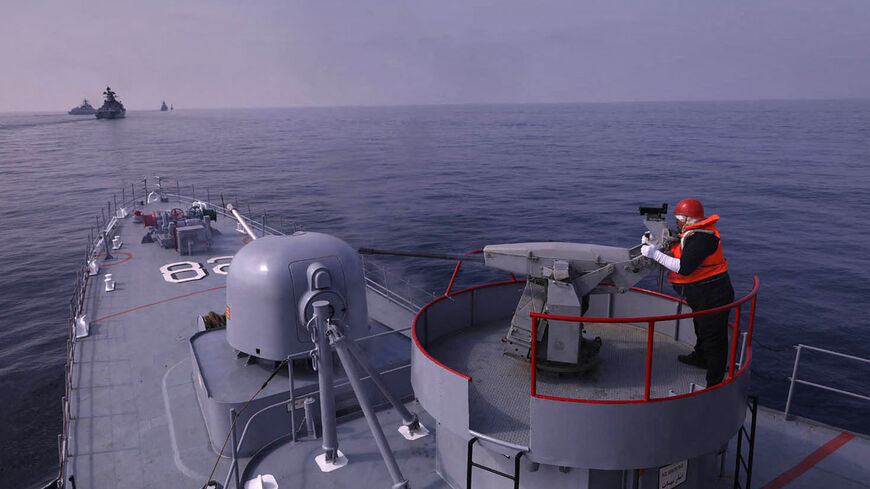TEHRAN — Iran's military forces wrapped up naval drills jointly conducted with two top allies, China and Russia, in the Gulf of Oman in what Tehran has projected as a major show of military might to its Western foes.
The four-day drills that were concluded last Sunday saw Chinese and Russian ships parading behind Iran's top destroyer, Jamaran, a Moudge-class frigate that joined the country's fleet in 2010. China’s South Sea Fleet warship, the Nanning, took part in the exercises, as well as Russian frigate Admiral Gorshkov, armed with hypersonic missiles. China's Nanning is a type 052D destroyer and bears similarities with the US Navy’s Arleigh Burke-class Aegis destroyers.
China's CCTV reported that the drills included live-fire suppression and strike practice with nighttime communication exercises.
From the Iranian side, the regular army and the navy of the Islamic Revolutionary Guard Corps (IRGC) both engaged in the war games. The stated goal of the "Marine Security Belt 2023," according to the IRGC-linked Tasnim News, was "bolstering maritime security and trilateral cooperation with a message of goodwill for global peace, and shaping a new naval community for a shared future."
Chinese destroyer Nanning returns to escort mission after drills with Iran, Russia
— Zhang Meifang张美芳 (@CGMeifangZhang) March 23, 2023
-enapp.globaltimes.cn/article/1287770pic.twitter.com/G594aE6J14
Reporting on the details of the drills, hard-line Fars News said they included such practices as fighting off mock aerial aggression and extinguishing maritime fire incidents.
"We predict that the participating countries and vessels will grow in number in the coming years," declared the drills spokesman, Rear Adm. Mostafa Tajeddini, in an interview with the state broadcaster, as he boasted about Iran's success in improving regional security. "Our neighbors have realized this, and they do understand today what country as a brother nation is supporting their well-being."
Following the fourth such joint exercise since 2019, Tajeddini said, the three countries have now established a new center for maritime security. "We cannot afford to allow extra-regional countries to come play the central role here," he said in what appeared to be a message for the United States.
On social media, government loyalists hailed the drills as a sign of the Islamic Republic's growing global influence. "When China and Russia, two Security Council veto-holding powers, propose to hold an exercise with Iran, it shows Iran's high military power in the world," one user wrote, arguing that such influence has been martialized "thanks to" the efforts made by slain top Iranian commander, Qasem Soleimani.
Opponents of the Islamic Republic, by contrast, downplayed the drills, with one user likening them to "a needle in a haystack" when compared to Israeli exercises jointly carried out with the United States over the past year.
As a strategic maritime route, the Gulf of Oman is of immense value to the region's oil-rich countries, on top of them Iran and Saudi Arabia, which earlier in March agreed to Chinese-mediated rapprochement and to put aside seven years of animosity.
While Saudi officials have voiced cautious optimism about the way the deal may unfold, Iranian authorities continue to take pride in their fresh "neighborhood diplomacy."
The Islamic Republic has over the past decade been promoting what it calls a "look to the East" policy, the favored foreign policy strategy of its Supreme Leader Ayatollah Ali Khamenei.
The 84-year-old cleric insists that Tehran will bypass Western pressure and sanctions through engagement with such countries as China, which is in turn currently attempting to jostle the United States from regional calculations with diplomatic drives, backed up by its traditional economic influence.







